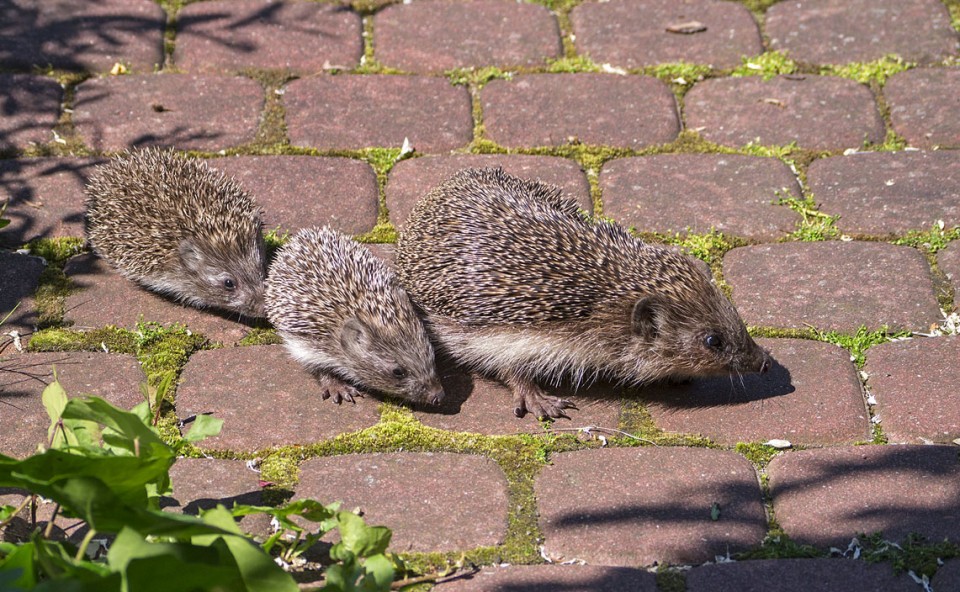European Hedgehog Breeding Biology - Birth & Development of Hoglets
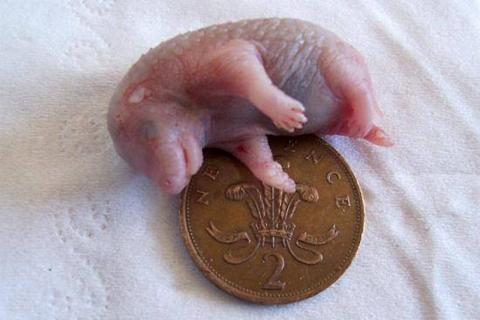
Observations of the birth of European hedgehogs are exceptionally rare, even in captivity; most occur overnight, according to Dr Bryn Morris. Some sows are extremely sensitive to disturbance during and shortly after giving birth, such that any interference within the first five days or so can result in her eating or abandoning her offspring. Disturbance more than about a week after the birth generally only causes the female to move her hoglets to an alternative nest. Hedgehogs are individuals and some mothers are more tolerant than others, but it is generally accepted that hoglets should not be handled until at least seven days old. (Note: As white-bellied hedgehogs, Atelerix albiventris, are fairly widely kept in private collections, there are several videos available of this species giving birth, and one anticipates European hedgehogs undergo a similar process.)
Despite the scarcity of reports, Nigel Reeve sums up the birthing process in Hedgehogs. The female lies on her side or on her belly with front paws extended and her rear end raised; alternatively, she may stand with her hind legs apart. She licks her genitals periodically, while trembling and straining against the contractions. The hoglets are encased in amnion and the spines are buried under a pocket of oedematous (fluid-filled) tissue that drains soon after birth - this protects the mother during birth and means they can be born head or tail first. The female quickly turns and consumes the placenta and birth membranes, licking the baby clean during the process. Some reports suggest that she then picks up the youngster and places it gently under her belly until the delivery is complete.
The birth of the whole litter can take anywhere from a few minutes to several hours (Pat Morris quotes two minutes per hoglet in his New Hedgehog Book) and the female will remain with the hoglets for the first 24 hours before leaving to forage. While the mother's out foraging, the hoglets will be in the nest huddled together for warmth—they have a large surface area to volume ratio, meaning that they lose heat rapidly and cannot thermoregulate fully until they're about one month old.
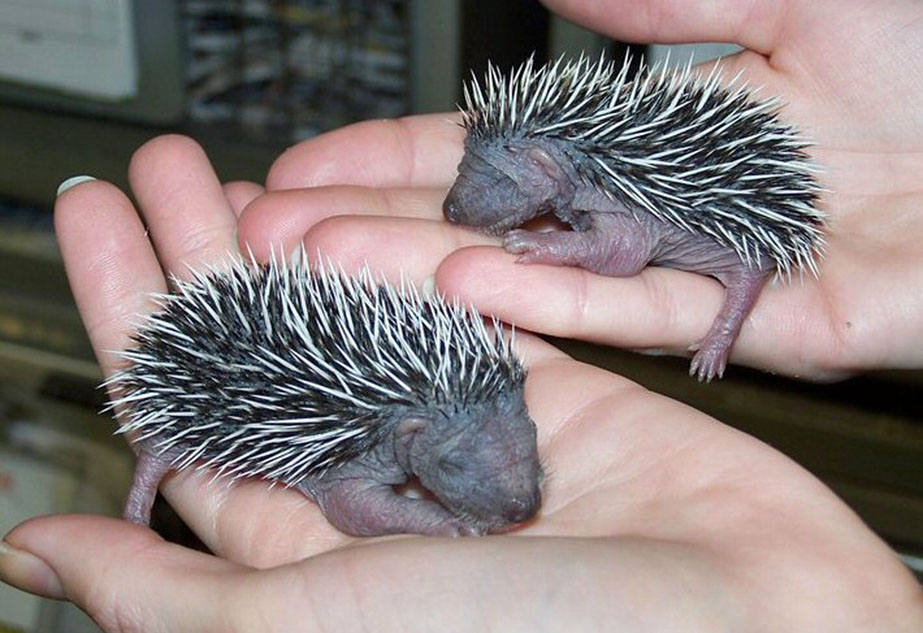
The mother stimulates her offspring to urinate and defecate by licking genitals and lapping at the excretions; this bowel stimulation is required until the hoglet is three or four weeks old. If the hoglet is separated from its mother, it emits a shrill piping call, similar to a high-pitched bird squeak, that stimulates the mother into retrieving it. Interestingly, although it is widely considered that sows will often eat very young hoglets if disturbed in the nest, in his book The Hedgehog Maurice Burton notes that they will adopt orphans:
“Anyone finding an abandoned baby and not wishing to hand-rear it can use another method provided they know of another hedgehog with a litter. Experience shows that a sow will readily adopt an orphan placed among her own litter if it is at or about the same age as her own babies.”
Indeed, in his 1966 International Zoo Yearbook paper, Bryn Morris observed that some mothers apparently lost interest in their litter after a period of apparently normal suckling, at which point the hoglets were successfully fostered by mothers with similar-sized young. I would, nonetheless, caution against attempting this with a female with very young hoglets. Burton goes on to suggest that human scent is unimportant to a sow, and she will accept hoglets that have been handled by humans. As with all wildlife, however, it is best not to handle more than is strictly necessary and wear gloves when doing so for your, and their, protection.
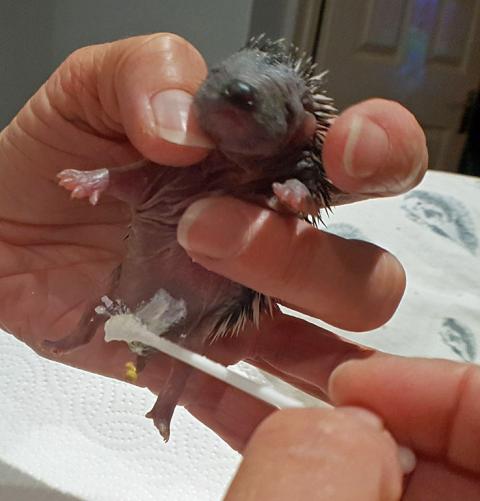
European hedgehogs have five pairs of nipples and the hoglets stimulate milk flow by kneading the area around the teat with their forepaws and rocking rhythmically back and forth while suckling. Little is known about the constituents of hedgehog milk, although one comparative study by Devorah Ben Shaul published in the International Zoo Yearbook during 1962 reported it to be just over 10% fat and almost 7.5% protein (compared to about 4% and 3.5%, respectively, for cow's milk) and has less water and sugar than cow's milk. Unfortunately, this paper gives no indication of the amount of milk tested or the number of replicates (samples), so the data should be considered tentative at best. Nonetheless, in their Natural Hedgehog, Lenni Sykes and Jane Durrant provide similar values for protein and fat content (6.5% and just under 10%, respectively), although they don't cite a source.
More recently, in a paper to the Journal of Animal Physiology & Animal Nutrition in 1998, E. Landes and colleagues presented their detailed analysis of the milk from four adult female hedgehogs brought to a rescue centre in Germany either pregnant or with suckling hoglets. The researchers observed that the milk was extremely rich in protein and fat, with very little sugar. Indeed, on average, they measured only 16g of protein, 26g of fat and 0.07g of lactose per 100mL of milk, although all components increased slightly during the first five weeks of lactation. So, most of the energy in the milk came from the fats, with around 30% provided by protein and only traces of sugar. The lack of lactose is not a surprise given that Susanne Struck, in her thesis on hedgehog nutrition published in 1995, reported that suckling hoglets do not have any detectable lactase activity; meaning that microbial fermentation of carbohydrates in the gut can easily lead to gastrointestinal problems. In other words, they're lactose intolerant. This is why cow's milk, which typically has about 5g of sugar per 100mL, is not a suitable food to put out for hedgehogs visiting your garden.
Hedgehogs produce altricial young—i.e. hoglets are born totally dependent on their mother for warmth and food. At birth, the hoglets measure about 7cm (just under 3 inches) and weigh between 8 and 25 grams (less than one ounce) depending on the number in the litter; the average birth weight is about 15g and it is exceptional for hoglets to exceed 20g. Hoglets are pink, hairless and their eyes and ears are tightly closed at birth—in the ear, the pinna is folded down to close the ear channel. Their backs are covered with small 'pimples' that betray the presence of spines below the skin; a set of about 100 white (first generation) spines begin to emerge within about an hour, although they may take 24 hours to be fully exposed—the spines grow in two distinct tracts with a partitioning down the middle.
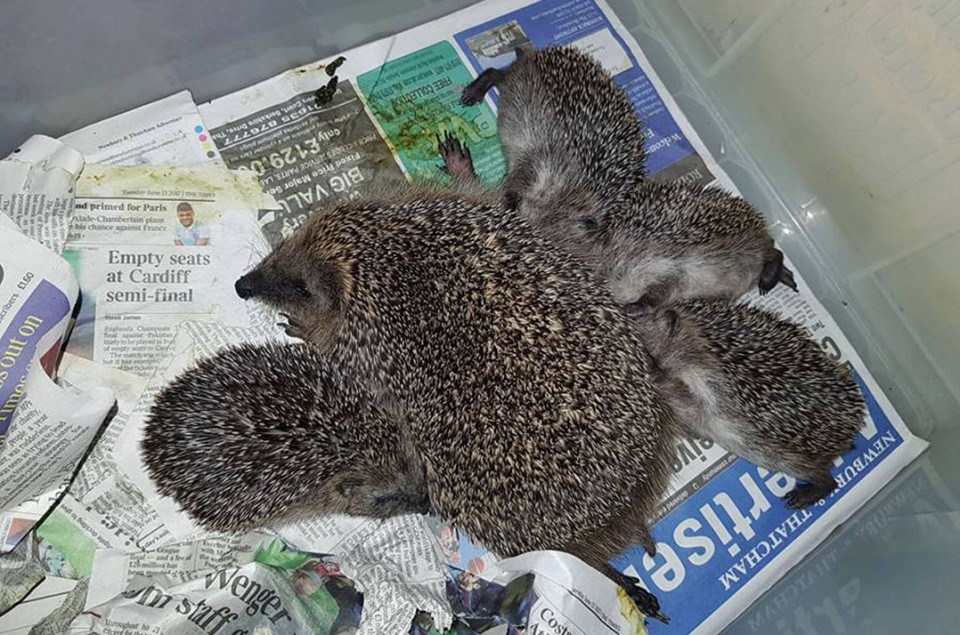
Contrary to popular misconception, these first white spines aren't soft; rather they are sharp and bristly and, if disturbed by a potential predator, a hoglet will call and snort while arching their back to jab at the intruder with their spines. Nonetheless, this first generation of spines are short (7mm or one-third inch) and weakly rooted in the skin. The second generation of spines are pigmented and begin development before birth; they erupt in between the white ones 36 to 60 hours (1.5 to 2.5 days) after birth, matching their length about 14 days later and obscuring them by 20 days (about 3 weeks) old. The second generation spines are smaller (only 12 to 15mm, or about half-inch) than the adult, or third generation, spines, but are otherwise identical to them. Shedding of the white spines commences at about one month old as the adult spines begin to grow; second generation spines start dropping out at about six weeks of age.
Hoglets have muscular control over their spines, allowing them to be erected, and begin growing hair at about one week of age. The eyes and ears open and the youngsters begin rolling up, although their morphometrics (body proportions) prevent them rolling into a tight ball, at about two weeks old; a covering of short fur is present by two or three weeks. The hoglets have lost their blunt snout and can roll up tightly by three or four weeks old. Hoglets are entirely lactophagus, i.e. they consume only milk, for the first three or four weeks of life, at which point their milk teeth have begun to erupt, allowing them to start taking solid food. Konrad Herter observed holgets taking solid food as early as 21 days old and Bryn Morris noted that his captive animals would start taking solid food at around 25 days old, although suckling continued for up to 44 days in one animal.
The Hedgehog Hotel documentary, aired on ITV in 2015, noted that the female will allow her hoglets to lick saliva from the corner of her mouth, although this does not appear to be a well documented behaviour. The suggestion is that the saliva may provide the hoglets with additional fluids or may help bolster their immune systems, but neither really seems an adequate explanation.
Once the hoglets begin to take solid food they start accompanying their mother on foraging expeditions. Many older natural history books contain drawings and/or descriptions of hoglets following their mother in single file, but it has been suggested that this may be the exception rather than the rule. Certainly, Maurice Burton found that despite his best efforts he could not encourage the litter of hand-reared hoglets to remain in single file. There are also some observations suggesting the mother can be very protective, recovering hoglets when they stray or get into trouble and even escorting them across the road. In a letter in The Countryman Animal Book, published in 1973, H. F. Barnes wrote:
“After squeaking intermittently for a few minutes, it edged one of its offspring off the pavement into the gutter and proceeded, with almost continuous squeaks, to run first on one side and then on the other of the youngster, which was thus directed diagonally across the road, straight towards a gateway a short distance down the side road. As soon as the little one was safely inside this entrance to another garden, the parent scuttled silently back across the road to where its remaining young were waiting. Then, squeaking again, it edged another off the pavement and escorted it across the road in exactly the same fashion. It repeated this procedure a third and fourth time, on each occasion bringing one of its family safely across.”
A hoglet will typically have doubled its birth weight in the first seven days and will be about ten-times its birth weight by six weeks old. Indeed, the hoglets are considered fully weaned by six to eight weeks old, with the adult dentition complete by four months. The newly-independent hoglets now spend their time feeding in preparation for winter. In the UK, a hedgehog should be at least 600g (1 lb. 5 oz.) by winter to stand a good chance of surviving hibernation. In continental Europe, where winters can be longer and harsher, the minimum weight is probably closer to 800g (1 lb. 12 oz.). In rare cases, litters born late in the year may have their weaning cut short by their mother's entry into hibernation. More likely, they will have less time to build up sufficient fat reserves to see them through the winter and stand little, if any, chance of surviving hibernation without human intervention—these often ill-fated individuals are often referred to as “autumn orphans” (see Helping Hedgehogs).
